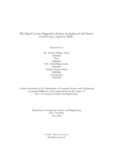| dc.contributor.advisor | Rahman, Md. Khalilur | |
| dc.contributor.advisor | Shakil, Shifur Rahman | |
| dc.contributor.author | Tonny, Ms. Ayesha Siddika | |
| dc.contributor.author | Hafsa | |
| dc.contributor.author | Lavlu, Md. Tousif Hasan | |
| dc.contributor.author | Ghosh, Abhijit Kumar | |
| dc.contributor.author | Roy, Sourojit | |
| dc.date.accessioned | 2023-03-22T06:35:35Z | |
| dc.date.available | 2023-03-22T06:35:35Z | |
| dc.date.copyright | 2022 | |
| dc.date.issued | 2022-05 | |
| dc.identifier.other | ID 18301197 | |
| dc.identifier.other | ID 18301205 | |
| dc.identifier.other | ID 18301190 | |
| dc.identifier.other | ID 18301191 | |
| dc.identifier.other | ID 18301199 | |
| dc.identifier.uri | http://hdl.handle.net/10361/18003 | |
| dc.description | This thesis is submitted in partial fulfillment of the requirements for the degree of Bachelor of Science in Computer Science, 2022. | en_US |
| dc.description | Cataloged from PDF version of thesis. | |
| dc.description | Includes bibliographical references (pages 41-42). | |
| dc.description.abstract | We are striving to build a realistic procedure by which we, particularly the future
generation, will be able to choose the right career based on their capacity and interests.
A few well-known international firms, including IBM, Unilever, LinkedIn,
Accenture, and others, utilize Pymetrics to hire their staff, which is based on cognitive
skills in the formal sector. Our work, however, is the first in the informal sector.
On our primary collected dataset, we used six distinct algorithms, including Logistic
Regression, Decision Tree, Random Forest Classifier, Support Vector Classification,
Multilayer Perceptron Classifier, and Extreme Gradient Boosting (XGB), and discovered
that Random Forest Classifier and Extreme Gradient Boosting (XGB) are
the best for this system, with the accuracy of 57% and 60%, respectively. We’ve
also used MinMaxScaler to enhance our output. After that, we observed that the
Random Forest Classifier approach had a nearly 62% higher accuracy. The Extreme
Gradient Boosting (XGB) approach, on the other hand, has a precision of 58.6%.
After completing our evaluation, we opted to use the Random Forest Classifier for
our system instead of MinMaxScaler. Based on these insights, we’ll match individuals
with employment, smoothing out labor market inefficiencies and leading to
considerable boosts in productivity, income, and well-being. | en_US |
| dc.description.statementofresponsibility | Ms. Ayesha Siddika Tonny | |
| dc.description.statementofresponsibility | Hafsa | |
| dc.description.statementofresponsibility | Md. Tousif Hasan Lavlu | |
| dc.description.statementofresponsibility | Abhijit Kumar Ghosh | |
| dc.description.statementofresponsibility | Sourojit Roy | |
| dc.format.extent | 42 pages | |
| dc.language.iso | en | en_US |
| dc.publisher | Brac University | en_US |
| dc.rights | Brac University theses are protected by copyright. They may be viewed from this source for any purpose, but reproduction or distribution in any format is prohibited without written permission. | |
| dc.subject | Career | en_US |
| dc.subject | Capacity | en_US |
| dc.subject | Interests | en_US |
| dc.subject | Cognitive skills | en_US |
| dc.subject | Informal sectors | en_US |
| dc.subject | Extreme Gradient Boosting (XGB) | en_US |
| dc.subject | Random Forest Classifier | en_US |
| dc.subject | MinMaxScaler | en_US |
| dc.subject | Pymetrics | en_US |
| dc.subject.lcsh | Machine learning | |
| dc.subject.lcsh | Artificial intelligence | |
| dc.title | ML based career suggestive system for informal job sector considering cognitive skills | en_US |
| dc.type | Thesis | en_US |
| dc.contributor.department | Department of Computer Science and Engineering, Brac University | |
| dc.description.degree | B. Computer Science | |

